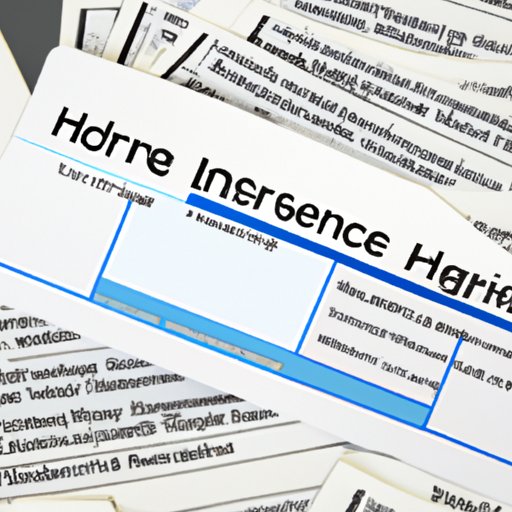Introduction
Health insurance is a critical part of protecting yourself and your family from financial hardship due to medical bills. Knowing if you have health insurance is an essential part of managing your budget and ensuring that you can access the care you need. In this article, we’ll explore the different ways you can confirm whether or not you have health insurance.
Research Your Employer’s Benefits Package
If you receive health insurance through your employer, your first step should be to research their current benefits package. Employers are required by law to provide employees with information regarding the type of coverage they offer and the associated costs. This information can be found in the employee handbook, on the company intranet, or by asking your human resources (HR) representative.
Overview of What to Look For
When researching your employer’s benefits package, you should look for information about the types of plans available, any associated premiums, deductibles, and copays. Additionally, you should also note whether the plan covers routine doctor visits, prescriptions, and mental health services.
How to Access the Information
Employers typically make this information available in the employee handbook or on the company intranet. If you cannot find it there, your HR representative should be able to provide you with the necessary details. They may also be able to answer any questions you have about the plan.
Review Your Paystubs for Insurance Deductions
If you receive health insurance through your employer, your paystubs should include deductions for health insurance premiums. These deductions will vary depending on the type of plan you have and the amount of coverage provided. It’s important to carefully review your paystubs to ensure that the deductions are accurate.
What to Look For
When reviewing your paystubs, look for deductions labeled “health insurance.” These deductions should appear as a separate line item on your paystub, usually near the bottom. They should also include the amount deducted for each pay period and the total amount deducted for the year.
Potential Issues to Be Aware Of
If you do not see these deductions on your paystubs, it could be an indication that you do not have health insurance. It could also mean that your employer has not deducted the appropriate amount for health insurance premiums. In either case, you should reach out to your HR representative to confirm your coverage and make sure that the deductions are accurate.

Contact Your Insurance Company Directly
If you purchase health insurance on your own, you should contact your insurance provider directly to confirm your coverage. Reaching out to your insurance company can help you understand the details of your plan and ensure that your coverage is up-to-date.
How to Reach Out to Your Insurance Provider
When contacting your insurance provider, you should do so in writing. This will allow you to keep a record of your communication and ensure that your questions are answered thoroughly. You can send your inquiry via mail, email, or fax, depending on your provider’s preferences.
Questions to Ask About Your Coverage
When reaching out to your insurance provider, you should ask questions about the type of plan you have, the coverage provided, and any associated costs. You should also inquire about any restrictions or limitations on your coverage, such as pre-existing condition exclusions or annual deductible amounts.

Check Your Health Plan Member ID Card
Your health plan member ID card is another way to confirm whether or not you have health insurance. The card includes your name, the name of your insurance company, and your policy number. It also lists the type of coverage you have and any associated copays or deductibles.
Where to Find It
Your health plan member ID card should be provided to you when you sign up for coverage. If you do not have a physical copy of your card, you may be able to access an electronic version through your insurance provider’s website or mobile app.
What Information to Look For
When reviewing your health plan member ID card, you should look for your name, the name of your insurance company, and your policy number. You should also check to make sure that the type of coverage listed is the plan you signed up for and that the associated copays and deductibles are accurate.
Consult Your HR Department
If you are still uncertain about your health insurance coverage after researching your employer’s benefits package, reviewing your paystubs, contacting your insurance provider, and checking your health plan member ID card, you should consult your HR department. They can provide you with detailed information about your coverage and answer any questions you may have.
Who to Contact
When consulting your HR department, you should reach out to the benefits specialist or the person responsible for managing employee benefits. They should be able to provide you with detailed information about your coverage and answer any questions you may have.
Questions to Ask
When speaking with your HR representative, you should ask questions about the type of plan you have, the coverage provided, and any associated costs. You should also inquire about any restrictions or limitations on your coverage, such as pre-existing condition exclusions or annual deductible amounts.
Conclusion
Knowing if you have health insurance is an essential part of managing your budget and ensuring that you can access the care you need. There are several ways to confirm your coverage, including researching your employer’s benefits package, reviewing your paystubs for insurance deductions, contacting your insurance company directly, checking your health plan member ID card, and consulting your HR department. By following these steps, you can verify that you have health insurance and understand the details of your coverage.
(Note: Is this article not meeting your expectations? Do you have knowledge or insights to share? Unlock new opportunities and expand your reach by joining our authors team. Click Registration to join us and share your expertise with our readers.)
